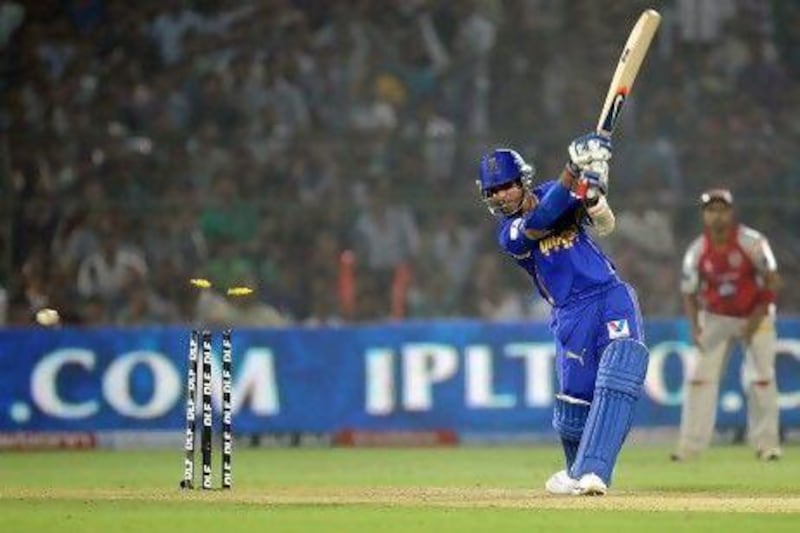It is back. But is the Indian Premier League bigger and better in its fifth season?
On the evidence so far, not really. The Royal Challengers Bangalore played their opening game on Saturday afternoon.
Given that it was the Easter long weekend, it was not unreasonable to expect a full house. Instead, you could spy empty seats in every stand.
What went on in the middle was equally underwhelming. The home side's margin of victory, 20 runs, was misleading.
Apart from the first four balls, where a stiff Zaheer Khan conceded 13 runs, the Delhi Daredevils never looked likely to chase down 158.
A look at their line-up was enough to tell you just why their fortunes have dwindled so dramatically over five seasons.
When they took to the field in 2008 for their first game, they had Virender Sehwag and Gautam Gambhir as their openers. Shikhar Dhawan, Dinesh Karthik and Manoj Tiwary, who formed the middle order, have all represented India.
Rajat Bhatia and Mithun Manhas were stalwarts of Delhi's Ranji Trophy side.
The specialist bowlers were Glenn McGrath, Daniel Vettori, Farveez Maharoof and Brett Geeves. Even the relatively unknown Tasmanian had an international cap.
Only Sehwag remains. Vettori was captaining Bangalore and he and Muttiah Muralitharan more or less toyed with a line-up that had no real batting quality to speak of once Sehwag departed when he slashed at the first ball he faced and was caught at cover.
They do have the explosive David Warner, but with Australia just having started a three-Test series in the Caribbean, he will not be available until early May.
England's Kevin Pietersen will also only be available for half the season.
Having missed Delhi's opening game because of the Test series in Sri Lanka, he will head back in May to prepare for the matches against West Indies.
Unlike several West Indians, who have chosen to represent their IPL franchises rather than don the maroon cap, the Australian and English contingents have made their priorities quite clear.
What the absentee list has done is open up more opportunities for young Indian talent.
Quite a few of them face a bizarre situation, where they need to perform in the Twenty20 format to ensure that they are not forgotten when India chooses their squads for the new season in July.
Prominent among them is Ajinkya Rahane, who struck a magnificent 66-ball 98 in the Rajasthan Royals' opening match.
Rahane's first-class record raises eyebrows. After 50 games, he averages an astonishing 68.47, with 18 centuries.
With Rohit Sharma prone to performing fitfully, many veteran Mumbai cricket watchers reckon that Rahane could be the inheritor of a tradition that has not unearthed a masterful batsman since Sachin Tendulkar all those years ago.
His star seemed to be in the ascendant when he was drafted in to the one-day squad in England, with India decimated by injuries.
In alien conditions, he did an excellent job, keeping his place for the home series against Alastair Cook's side.
He failed a couple of times, but was also instrumental in clinching the series with two games to spare. At Mohali, where India chased down 299, his contribution was 91.
While Rahane may become equally proficient at the one-day formats as Rahul Dravid - his Rajasthan captain - did, the reality is that he should be the first name under consideration for a Test spot as India look to the future without a No 3 who made more than 13,000 runs.
Virat Kohli has established himself, but another space will open up soon with VVS Laxman also on the threshold of an exit.
The irony of it is that Rahane and Cheteshwar Pujara, another contender who did so well on Test debut against Australia in 2010, have only the IPL to stake their claim. Both men have opened the innings for their franchises, but in a format where leaving the good ball alone is seldom an option.
With only home Test matches on the horizon though, it is not the batting that India need to worry about.
Apart from five or six sessions, the bowling in both England and Australia was pitiful, far short of what one expects from a team with pretensions to being the best.
The contrast with England was stark. Although the English lost four of five Tests in the UAE and Sri Lanka, there was no lack of potency from the pace attack or the spinners. Most of the time, poor planning and execution from the batsmen squandered the advantages gained by the bowlers.
India's trump card at present is an increasingly creaky Zaheer. The chances of him playing all 10 Tests - two against New Zealand and four apiece against England and Australia - are next to nil, and with the erratic Ishant Sharma having recently undergone surgery, there is little experienced backup.
Umesh Yadav, who excelled at home against the West Indies and bowled a couple of fiery spells in Australia, is the only genuine pace option, while Ashok Dinda will try to use the IPL to show just why Sourav Ganguly rates him the best of the bunch.
With change imminent, it is up to the IPL generation to show what they can do. Even if the audition's in the wrong kind of clothes.
Follow us
[ @SprtNationalUAE ]





